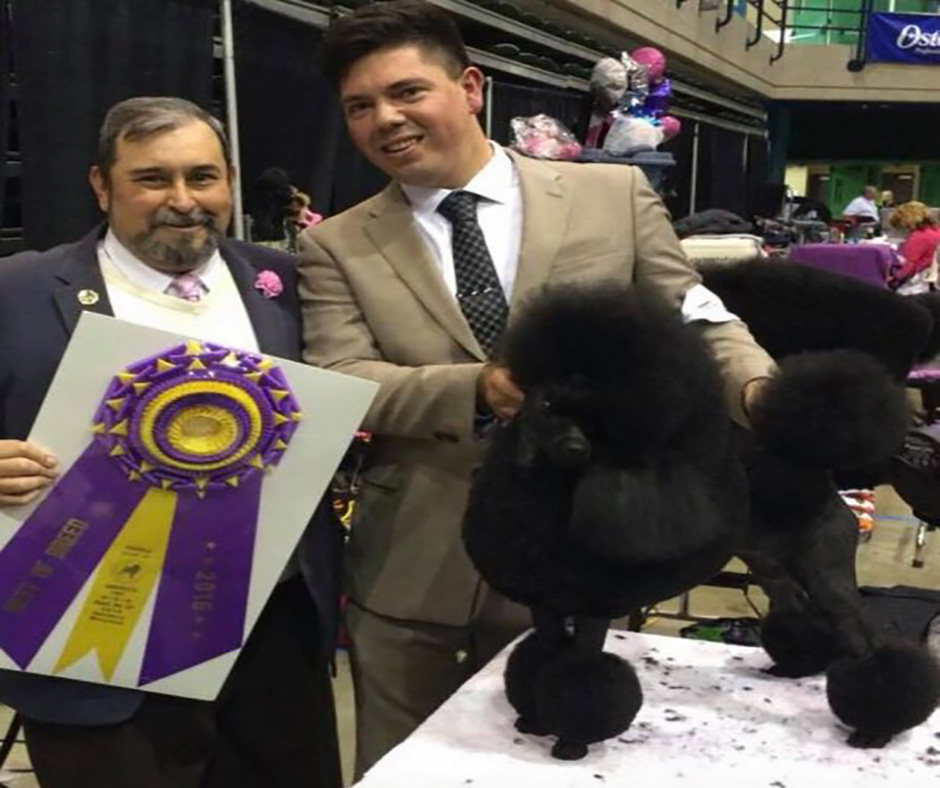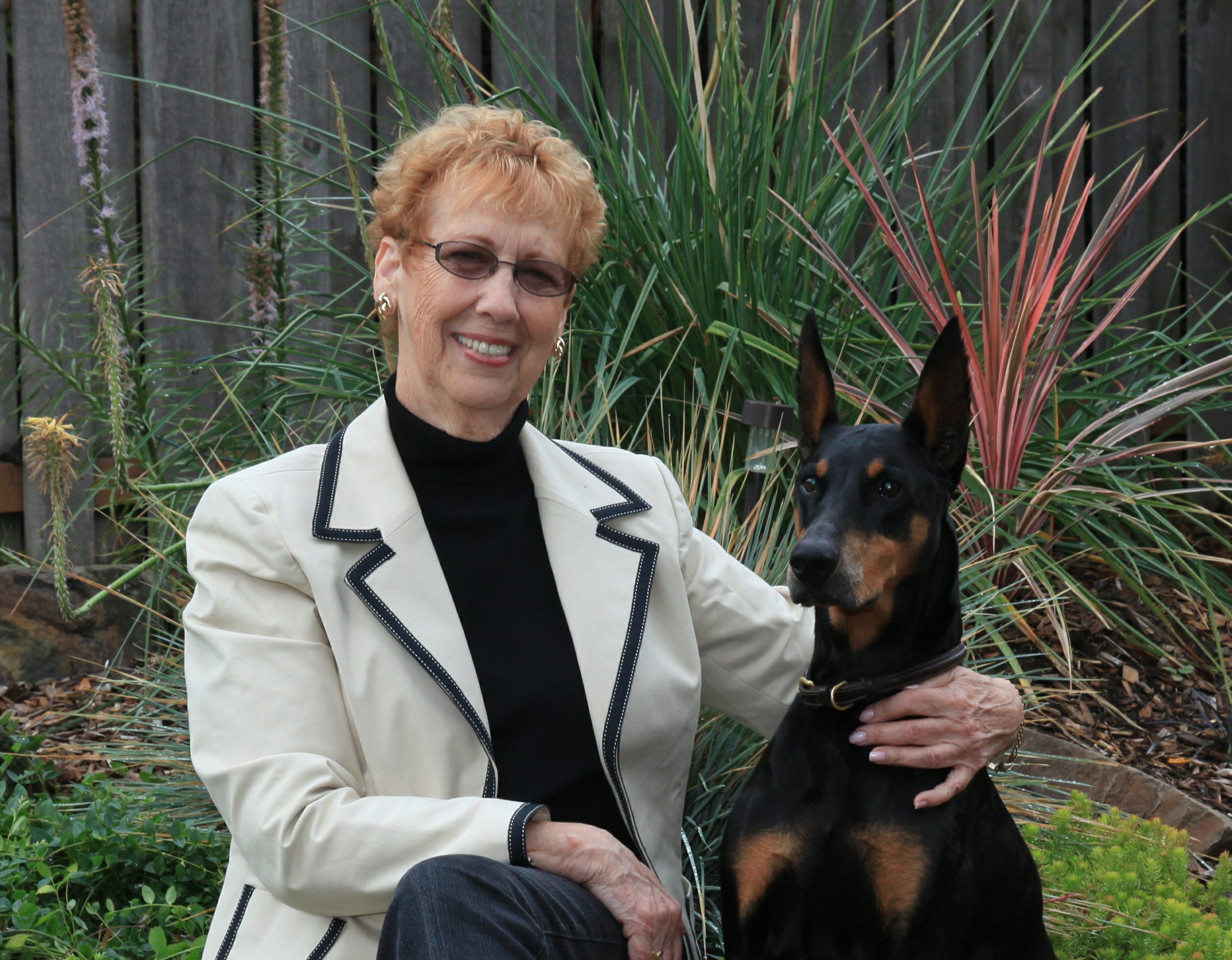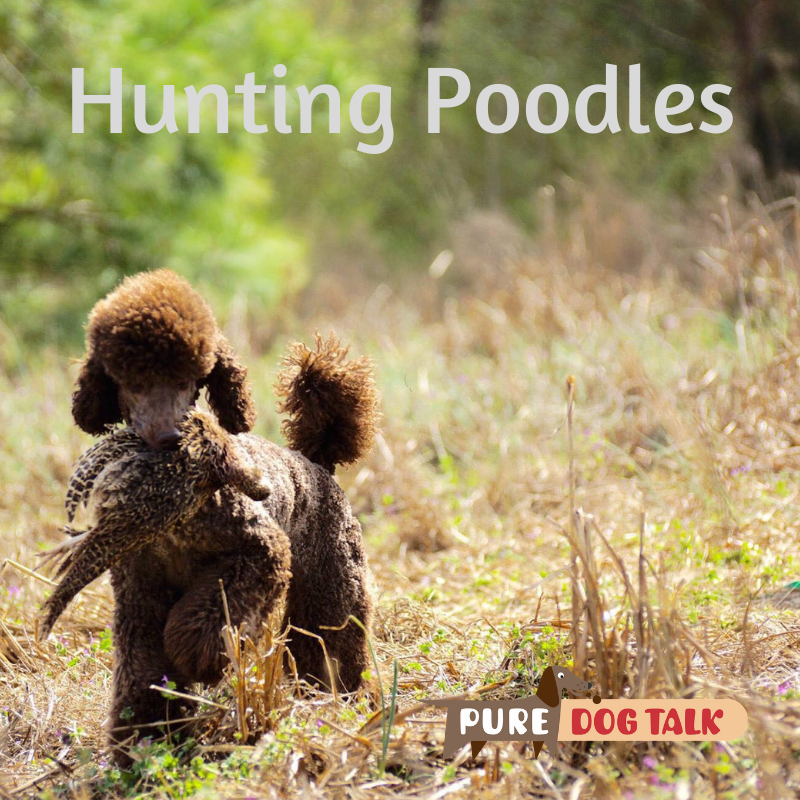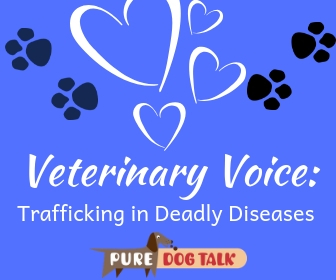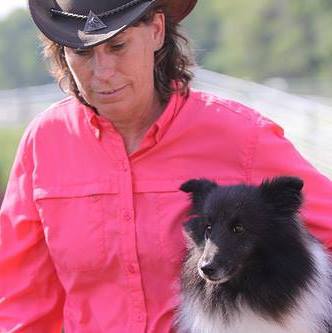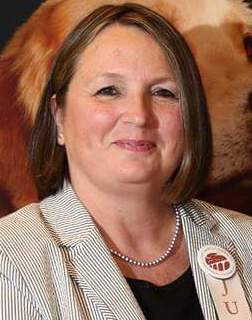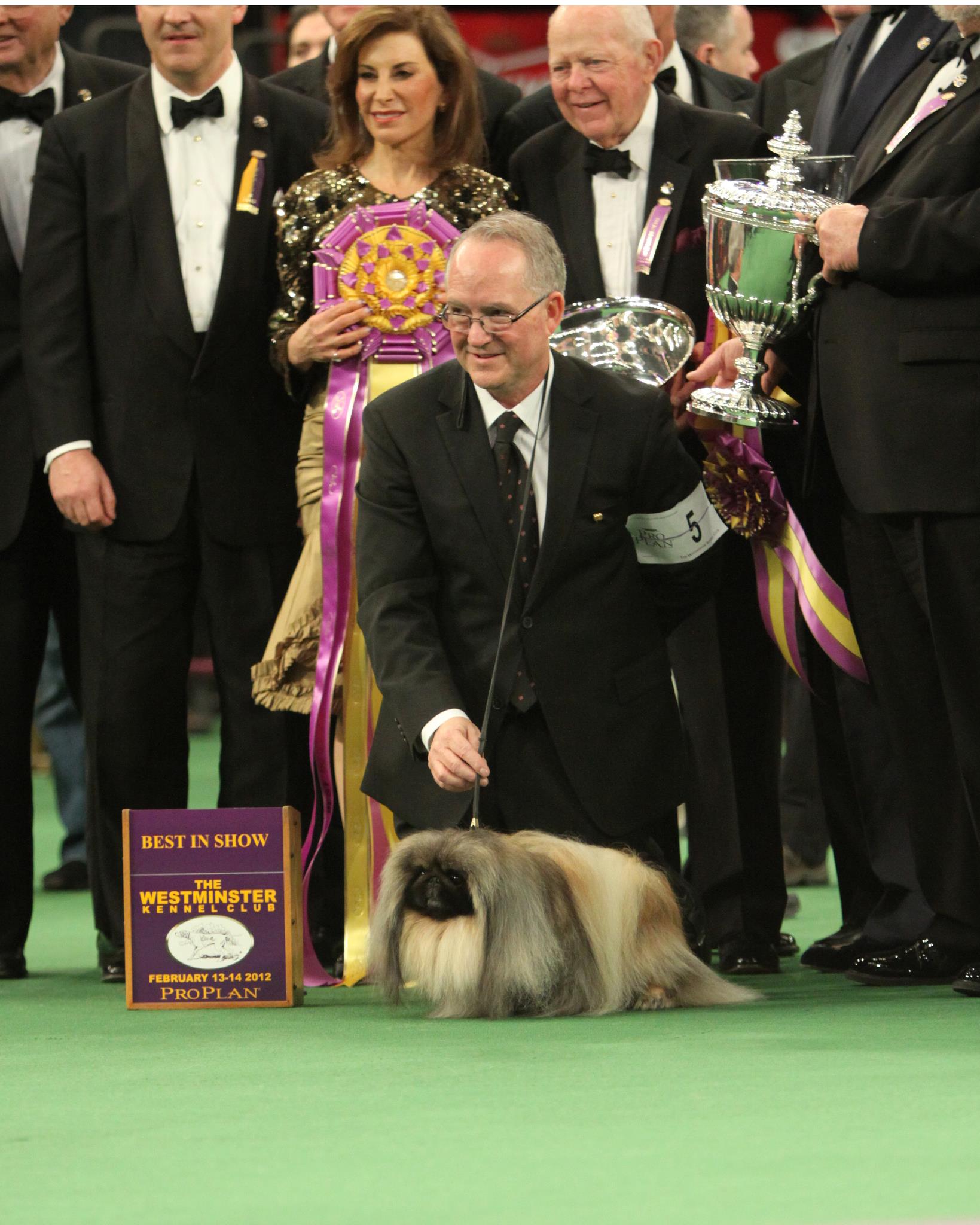279 – Brian Cordova on Poodles, PCA and the Definition of “Poodly”
Brian Cordova on Poodles, PCA and the Definition of “Poodly”
Miniature Poodle breeder Brian Cordova visits with host Laura Reeves about all things “poodly,” PCA (hint, Christmas in April!) and meeting “god.”
Poodle Club of America, currently hosted at Purina Farms in Missouri, in the early days was an outdoor event on the East Coast, for many years in Maryland. Cordova said the decorations at Purina Farms will make it seem like the dogs are being shown at a park, but with the convenience of being indoors.
Poodles, while attracting luminaries of purebred dogs, can be controversial, Cordova said, because of the trim. The continental clip, which served a function for the breed when retrieving waterfowl, is just window dressing he added.
“Ignore the trim and look at the legs and bones and what you’d judge on any other dog,” Cordova said. “The dog has to be sound. The rest of it is just fancy. When you say ‘poodly,’ people know what that means. It’s carriage and distinction.”
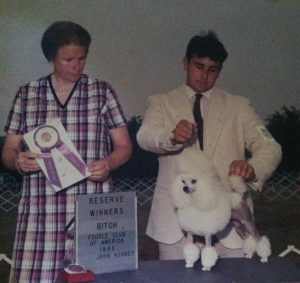
Cordova shows Cha Cha, Ch. Bragabout Dancing Mistress to RWB under “god” Anne Rogers Clark, at PCA. “Cha Cha was a group winner from the classes and was RWB here at PCA in a Gigantic entry of toy bitches. She was defeated by a Delorch bitch from Am. Bred who then won BOV handled by Diane Artigues,” Cordova said.
Cordova remembers his singular visit to the home of Anne Rogers Clark, while he was an apprentice for legendary handler Tim Brazier. The team was showing Clark’s Poodles at the time. There, on “god’s” refrigerator, was a picture of Cordova with Mrs. Clark’s dog.
“It was spine tingling,” Cordova said.
Much of the excitement in Poodles today surrounds the Standard variety, but Cordova said miniatures used to be the popular variety.
“There would be hundreds of (miniatures) entered everywhere,” Cordova said. “But PRA blindness decimated the variety. They really took a tough turn.” Fortunately, he said miniatures had largely separate gene pools for black/brown and white colors. Breeders were able to cross the color gene pools to help clear the problems and build back. When testing for PRA became available, Cordova said that made a huge difference for the variety.
Cordova shared PCA memories going back 30 years of dogs and people. He vividly describes a memory of standing on a field dripping in sweat, watching miniatures, while the judge ran two outstanding bitches of the day against each other.
278 — Pat Hastings Wants to Make YOU a Winner With New Book
Pat Hastings Wants to Make YOU a Winner With New Book
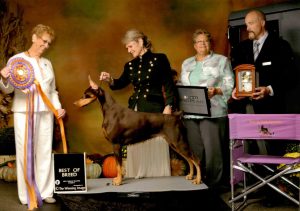
Pat Hastings awarding Best of Breed at one of four Doberman Pinscher Club of America national specialties she has judged.
Author, breeder, handler, judge. Pat Hastings has worn an array of hats in the dog world. Her new book “Let’s Make You a Winner: A Judge’s Perspective on Showing Dogs” is the most recent offering in what she calls a sort of accidental journey.
“Puppy Puzzle,” Hastings first and most well-known project, started with structural engineers. Separating hearts from minds enables people to see the structure. It isn’t difficult to understand, Hastings said, but dog people have failed to see the obvious. “Whether it’s dog breeding or bridges, if you don’t build them for the purpose you use them, they break.”
The more we learn, the more our dogs benefit

Pat Hastings’ new book, “Let’s Make You a Winner” is available for purchase at her website.
Hastings noted that one critical “engineering” concept that made an impact on her was that a majority of breeds have three natural balance points.
“The head must be above the topline, the neck must be in front of front legs, and the rear slightly behind,” Hastings said. “The better made the dog is, the easier for it to stand still.”
Another “blinding flash of the obvious” Hastings describes learning regards front assemblies.
“Everybody talks about short upper arms. It’s really easy when you realize that the prosternum is always in a direct line with the point of shoulder,” Hastings noted.
“I have never done a seminar in my life that I didn’t learn something,” Hastings added.
Frustration prompted new book
“As a judge it is frustrating to not be able to put up a nice owner handled dog because they haven’t done anything right. They haven’t raised it, trained it or conditioned it to win. They could be doing so much more winning if they would learn how to do all of it.
“It’s really frustrating to hear people complaining about handlers winning. The handler isn’t what’s beating them. The whole package is winning,” Hastings noted. “There are a lot of really good dogs out there that should be doing more winning, but somebody needs to teach them.”
All of Hastings books, DVDs and more are available at her website: https://www.dogfolk.com/
277 – Hunting Poodles at Poodle Club of America: No, Really!
Hunting Poodles at Poodle Club of America… No, Really!

Jaci Bowman hunting with two standard poodles
Jaci Bowman, owner, trainer and handler of hunting Poodles, joins host Laura Reeves to talk about retrieving, upland bird hunting and the history of poodle participation in hunt tests.
Bowman began hunting with her poodles in the 1990s. She said that Poodle Club of America originally created a working certificate for the breed, but later poodles were accepted to compete in AKC licensed retriever hunt tests. Three years ago, poodles were also approved to participate in AKC’s hunting tests for spaniels.
From the PCA website: “Upland hunting traditionally consists of walking through the fields, locating birds, flushing them out of cover, and shooting and retrieving them. Upland hunting varies widely from the sparse vegetation of the high desert, to the high cover of corn fields, to the dense cover of fence rows, to woodlands. The type of bird varies, based on the habitat. Game birds include pheasant, chukar, partridge, woodcock, doves, various kinds of quail and grouse, and pigeons. With all of them, a good dog makes a valued hunting partner, a role that poodles have been filling for a long, long time.”
Poodle History
The breed was developed to hunt in marshes, with ancestry tracing to the Irish Water Spaniel, Bowman noted. As a result, they aren’t what she thinks of as “non-slip” retrievers like Labradors and Chesapeakes that were developed exclusively for retrieving downed waterfowl.
Not Just Show Dogs
PCA national events feature a working certificate test, a retriever test, and a spaniel test, along with an opportunity to introduce new dogs and owners to the sport.
Bowman said that even though the field events are held before the dog show, newly popular “modified” trims enable dogs to transition from one to the other easily. Many of the dogs competing in the field tests are also show champions and compete in other performance venues like agility and obedience as well.
276 – Trafficking in Deadly Diseases from Foreign “Rescues”
Trafficking in Deadly Diseases from Foreign “Rescues”
Our guest blog post today is from Nancy Melone, with additional information about the deadly diseases arriving with foreign “rescues.” Thank you for this outstanding research Nancy!
Protecting North American Dogs from Imported Disease Pathogens: The Cases of Dog Flu and Distemper*
By Nancy Melone, PhD, ThornCreek Bernese, Reg’d. and Eendenkoi Kooikerhondjes
Abstract: Protecting dogs and people from imported disease pathogens is a difficult and never-ending task requiring international cooperation and continued vigilance. The recent cases of dog flu and distemper offer vivid examples of the costs, both financial and emotional, of failure to responsibly import animals. This article describes the obstacles to such protection and the process of tracking and identifying unknown pathogens using dog flu and distemper as examples.
Protecting companion animals in the US from infectious organisms brought in by imported companion animals is not easy. Unlike the importation of food animals (e.g., cattle, sheep) which is overseen by the US Department of Agriculture, there is no federal oversight over the importation of companion animals. The only requirement for dogs entering the US or Canada is a rabies certificate. As became terrifyingly clear when several dogs imported from India, Iran, and Egypt were found to be rabid despite being “vaccinated,” fake rabies certificates are easy to obtain in some countries. Absent federal oversight, Professor Edward Dubovi, Director of the Virology Laboratory at Cornell University’s Animal Health Diagnostic Center, says, “It’s a 50-state free-for-all with regard to [importing] companion animals. It’s a very unsatisfactory situation if you’re trying to control infectious diseases in our domestic cats and dogs.”
The advent and popularity of international dog rescue and increased international and interstate trafficking of dogs has ushered in a new set of animal and human health concerns among infectious disease specialists, veterinarians, physicians, and epidemiologists as well as pet owners and breeders. Companion animals, in particular the family dog, are often seen as sentinels for known and unknown diseases in humans. They are the proverbial canary in the mineshaft. When dogs are imported from around the globe, they can become vectors of diseases that have never been seen in North America. Even diseases that have been eradicated and not seen in the US for decades may pose problems because of drug resistance. Many imported animals, particularly those rescued from underdeveloped or poor nations, enter North America with inadequate veterinary screening, veterinary care, or the benefit of basic vaccination protocols typical of dogs living in the US or Canada. In countries where dogs are raised for meat and regulation of antibiotics is poor, the risk of importing antibiotic-resistant pathogens is very high. Other factors further amplify disease risk, including, but not limited to, international rescue organizations who fail to develop and follow proper quarantine, disinfection and vaccination protocols. However well-intentioned, these rescue efforts put North American dogs at risk of foreign strains of potentially drug-resistant or unknown disease. Diagnosis of sick dogs becomes even more complicated in the case of unknown diseases, because if you have never seen or do not know what you are looking for, it is often hard to find it and when you do, it is often too late. To the extent imported dogs bring in unknown pathogens that are communicable to humans breeders, dog owners, rescuers, veterinarians, and adopters and their extended families are at potential risk.
The Case of Dog Flu
As many dog owners may recall, a primary focus in the last decade was the containment of two strains (H3N8 and H3N2) of the Canine Influenza Virus (CIV). So-called “dog flu” was unknown in the US until a mysterious illness struck racing greyhounds in Florida in 2003 and again in Texas in 2004. Rapid response by researchers and epidemiologists at Cornell and the University of Florida identified the virus as H3N8 and limited its spread. Retrospective analysis of stored lab samples indicated the virus, equine in origin, had been circulating in the US as early as 1999. In 2015, a larger outbreak of 1000 dogs occurred at a Chicago dog shelter. The virus (H3N2) was typed and found to be avian in origin. It was traced back geographically to China and South Korea and established that the virus had spread to the general dog population.
A vaccine for CIV exists now and is recommended for dogs at potential risk (e.g., show dogs, dogs attending activities such as training classes, doggie daycare or boarding at kennels). Unlike human flu, there is no “flu season” for dogs, so risk is nearly the same throughout the year for dogs.
Currently, CIV is not thought to be transmissible to humans (i.e., zoonotic). There has been no reported case of human infection with a canine influenza virus in the US or worldwide. In 2016, the Centers for Disease Control and Prevention (CDC) determined that the potential pandemic risk of CIV H3N2 viruses was low. However, according to Dr. Stephen Colodny, MD, Pittsburgh infectious diseases specialist, influenza viruses are constantly changing and H3N2 could mutate so that that CIV could infect people. CDC professionals worry that novel new non-human influenza A viruses against which humans have little immunity have the potential for causing an influenza pandemic.
The recent dog flu experience reminds us, too, that canine Imported pathogens not only risk the lives of domestic dogs and possibly humans, but also impose enormous costs on dog owners. Estimates of the cost of the 2015 CIV outbreak to US dog owners run as high as $75 million in diagnostic testing and vaccinations alone.
The Case of Canine Distemper Virus
Fast forward to early October 2018. The attention of epidemiologists shifted to a new pathogen. Twelve days after arriving in Western Canada, a 3-month old “Sheltie” puppy, allegedly rescued from a Korean dog meat facility, became mortally ill. The dog’s initial symptoms were lethargy and coughing. Bloodwork indicated that the dog had “anemia.” Approximately 10 days later, the dog developed involuntary muscle twitching and jerking on one side of the body (unilateral myoclonus) and relapsing lethargy. After another week, the dog suffered persistent tonic clonic seizures (e.g., unconsciousness, stiffened muscles and muscular jerking). When seizures worsened, the dog was euthanized.
The subsequent process of identifying the unknown pathogen was a directed search that involved international cooperation. Samples from the sick Korean-Canadian dog were sent to Cornell University’s Animal Health Diagnostic Center to see if the disease was H3N2 Canine Influenza Virus, which is the endemic strain of Influenza A in Korea. In addition, samples were tested for Canine Distemper Virus (CDV). Results were negative for flu, but swab and urine samples were strongly positive for distemper. Initial attempts to isolate the virus were unsuccessful, but later genetic analysis indicated that the virus was very similar to the Asia-1 strain of CDV. This lineage/clade is not among the native North American strains of CDV against which most dogs in the US are vaccinated. Indeed, Asia-1 had never been seen in the North America.
Canine Distemper is a highly contagious, systemic viral disease infecting dogs worldwide. It is transmitted dog-to-dog through the air by coughing or barking and through feces and urine. Occasionally there are CDV outbreaks at dog shelters, but for the most part CDV affects carnivorous wildlife populations including raccoons, grey fox, skunks, coyotes, and wolves. To the extent Asia-1 infects the carnivorous wildlife population, eradication is impossible. With regard to zoonotic potential, humans who have not had measles or who have not been vaccinated against measles are vulnerable to asymptomatic CDV. Scientists at Cornell indicate that “dogs already immunized against CDV likely are not at risk from the Asian strain.” Unvaccinated dogs and puppies who are too young to vaccinate may be at risk.
According to researchers at the University of Georgia, despite intensive vaccination programs in developed nations around the world, there is evidence recently of re-emergence and increased CDV activity worldwide, including in the US. This recent discovery of Asia-1 lends additional support to that conclusion. In the 2018 study (using samples from 2014 to 2017), Georgia researchers found after analyzing the CDV H gene that there are at least 3 different CDV lineages circulating in the US. These lineages included America-3, America-4, and a lineage previously reported in connection with an outbreak in Wyoming which was linked to a domestic dog breeding facility in Kansas in 2010. These lineages are not the same as the lineages found previously in the US, including America-1, which contains the majority of the vaccine strains. The researchers worry that these genetic differences could lead to vaccine failure. Analysis of other CDV-relevant genes produced similar results. The bottom line is that CDV requires continuous monitoring of circulating CDV strains in the US to prevent potential vaccine breakthrough.
What Do Concerned Dog Owners and Breeders Do?
As in all decisions involving risk, North American countries and dog owners must assess how much risk they are willing to tolerate and then develop coherent policies for managing those risks. International rescue organizations must take on the responsibility of not only helping international dogs at risk but also implementing protocols to protect domestic dogs from imported pathogens. Ideally, international rescue organizations would work to educate and place these rescued dogs in their countries of origin rather than importing them to North America. To the extent these organizations do not accept that responsibility, stricter domestic regulation of companion animal imports from high-risk regions should be pursued.
Domestic dog owners must also assess the risk for their own dogs in a world where imported unknown pathogens are likely. Since these risk assessments may vary across people, we may not all agree on the need for vaccines. If one chooses not to vaccinate, be aware that to achieve herd immunity, a substantial number (depending on contagion) of dogs must be vaccinated or have caught and survived disease. Ideally, herd immunity is reserved to protect those dogs (or humans) who cannot be vaccinated because they are pregnant, too young to be vaccinated, or because they are immune compromised because of age or disease. As such, herd immunity is not intended to protect healthy dogs who could be vaccinated with minimal risk.
The recent human measles outbreak illustrates the role vaccination and contagion rates play in achieving disease protection. For example, if we look at the recent outbreaks in both Washington state and New York state, the number of people who need to be vaccinated to obtain herd immunity for measles is around 95% because of the highly-contagious nature of measles. One measles-infected person infects on average about 15-18 other susceptible people. This rate of contagion is called the R0 (pronounced “R-naught”). In the New York outbreak, the number of vaccinated people had dropped to only 73%, considerably below the 95% necessary for herd immunity, hence given the highly contagious nature of measles, the outbreak was no surprise to public health officials. Such was also the case in Washington state. Measles, a preventable disease, kills many unvaccinated children and adults each year. Influenza is similar. We can easily translate these examples to the dog world.
Based on current information, if your dog attends training classes, dog shows, doggie day care or frequents areas where there are dogs of unknown vaccination status or wild animals (e.g., dog parks, community parks, rural areas) consider vaccinating your dog for CIV and CDV. If you cannot or wish not to vaccinate your dog, do not socialize him with unvaccinated dogs or take him to places where wild animals are likely to have urinated or defecated.
If you import a dog (an international rescue or a puppy from a breeder whom you do not know and with whom you do not have a trust relationship), revaccinate for rabies and DHPP, quarantine for 30 days, do a brucellosis test at day 1 and again at day 30. If the dog is healthy at day 30 and negative for brucellosis at day 30, you can probably introduce it safely to your dog family or breeding kennel.
According to Pittsburgh infectious disease specialist, Stephen Colodny, MD, in cases where there is a rare virus that does not warrant the substantial investment required for vaccine development, early detection and prompt treatment of those who are infected are critical in preventing human epidemics.
Conclusion
The threat of new and unknown pathogens to our dogs and dog owners is constant, requiring ongoing international cooperation and vigilance. While dog flu and the Asian strain of distemper occupy our current focus, there will always be new disease threats lurking around the corner because pathogens are adaptive, clever and stealthy. While the epidemiological process for discovering and identifying each of these threats may be similar, the work is difficult and never ending. Dog breeders and rescuers who bring foreign dogs into the country play a critical role in disease prevention. People who have no regard for the potential to import disease when importing dogs selfishly put us all at risk.
References
American Veterinary Medical Association, “Canine Influenza.” https://www.avma.org/KB/Resources/Reference/Pages/Canine-Influenza-Backgrounder.aspx, as viewed March 20, 2019.
Anis, E, Newell, TK, Dyer, N, and RP Wilkes, “Phylogenetic analysis of the wild-type strains of canine distemper virus circulating in the United States,” Virology Journal (2018) [15:11]8. Https://doi.org/10.1186/s12985-018-1027-2
Centers for Disease Control and Prevention. “Key FAQs about Canine Influenza (‘Dog Flu’)” https://www.cdc.gov/flu/other/canine-flu/keyfacts.html, as viewed March 20, 2019.
Cornell University College of Veterinary Medicine (Patricia Waldron), “New Strain of Sanine Distemper Virus Arrives in North America, March 18, 2019. Https://www.vet.cornell.edu/news/20190318/new-strain-canine-distemper-virus-arrives-north-america, as viewed March 20, 2019.
Acknowledgements
Special thanks to Stephen Colodny, MD, Pittsburgh human infectious disease specialist, Larry Gerson, VMD, and Marti Greer, DVM, both breeder-vets, for their helpful comments. I thank my breeder friends, Sandy Dunaway (Summit Bernese), Linda Seaver (Tschuggen Bernese), Cindy Valco (Summer St. Bernards) and Ann Knoop-Siderius (Iserman Kooikers) for helping me stay above the weeds so that average dog owners can find value in this article. I can never thank my proof readers/grammarians, Ellen Folke and Timothy W. McGuire, PhD., enough for their help throughout the years.
About the Author
Nancy P. Melone, PhD, is a graduate of the University of Minnesota in Information and Decision Sciences. Her articles on canine health have earned The Dog Writers Association of America’s Maxwell Medallion, the Morris Animal Foundation Advances in Canine Veterinary Medicine Award, and the American Kennel Club Publication Excellence Award. Dr. Melone formerly served on the boards of The Berner-Garde Foundation, Inc. and Bernese Auction Rescue Coalition (BARC), Inc. She is editor emerita of the BMDCA’s The Alpenhorn. Currently, she serves on the board of the Nederlandse Kooikerhondje Club of the USA and is chair of the Health and Genetics Committee.
*The author makes no warranties, expressed or implied, to representations of correctness of any content including, but not limited to, methods of diagnosis or recommendations of treatment. The information in this article does not substitute for appropriate professional veterinary medical care and treatment of your dog.
275 — PureDogTalk’s “News” Report for Monday, April 1
All the News That’s Fit to Record
Welcome to Pure Dog Talk’s “News” Report for Monday, April 1, 2019. I’m your host Laura Reeves.
We start today’s show with a brand new report that the Labrador Retriever, America’s most popular dog for, like, a million years running, will be the star of the show at a specialty featuring more than ONE THOUSAND Labs, all wagging their tails in sync, at the Labrador Retriever Club of the Potomac. This mind-boggling event, held April 8-12 in Fredrick Maryland features, amongst any number of amazing opportunities to be bruised by a Labrador tail, a *stud dog auction* —- just think! High bidder wins what?? Swimmers!!!
Here at Pure Dog Talk, twice a week we bring our listeners all the news that’s fit to record in regards to our canine companions. And next on the list of major announcements for today is the GALA Poodle Club of America *hunting* entry! Before the Labs even finish up in Maryland, the Poodles take to the field in Missouri! Listen in next week when I talk with an actual goddess of hunting poodles!
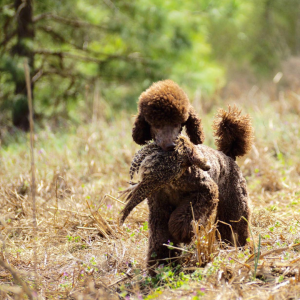
Hunting Poodles Come to Missouri
Anyone who ever had any doubt, Poodles are *clearly* a superior species! This is clearly proven by their ability to carry themselves with dignity no matter what kind of crazy trim their owners opt for… But also because Poodles can earn titles in BOTH a spaniel hunt test (flushing) AND a retriever hunt test (retrieving), in addition to working certificate tests, and, for those who just can’t believe a floofy show dog can be a bird dog too, they offer the opportunity for field aptitude evaluation!
We promise this will be better than reading the Mueller report! PS I know a WHOLE bunch of my fans are “in” to murder podcasts… just *sayin* !!! While I KNOW the organizers will work hard to make this a “genteel” exercise, facts are facts…. Bird dogs’ (of which poodles are one) *natural instinct* is to HUNT and DISPATCH prey for dinner….. “Dog murders duck in Missouri” is a headline for which you should be mentally prepared…
PCA says: Bring your dog in a flat buckle-type collar and your dog’s favorite toy and see if training to be a retriever is for YOU! We’ll supply the information and any other equipment such as long lines, birds (big and small), wings, bumpers, duck calls, etc. We’ll start by outlining the basics of retriever training, move on to play retrieving with your dog and continue with an introduction to birds. Come watch Poodles at work on land in the morning, experience the basics of retriever training at mid-day and stay to watch Poodles tackle the water in the afternoon. Be sure to bring a chair and water for your dog!”
In 2017 *34* poodles were entered in the national hunt tests. So the next time you see a poodle all dressed up with places to be in the show ring, shaved and sculpted and sprayed to the nines, remember that half those 34 dogs passed their tests, even at the master level, and of those, four were also show champions! And THAT is NOT an April Fool’s joke!
Meanwhile, in one short month, on May 1, we’ll be celebrating National Purebred Dog Day, a day we enjoy the diversity of our breeds like the Pug, a small version of the Mastiff used in battle, though the Pug had the unique position of attacking ankles and not horses, according to NPDD founder, Susi Szeremy.
We also celebrate Spinone Italiano, which my mother and I saw for the first time — sometime in the ‘80s — in the international encyclopedia of dogs and proclaimed “LOOK! It’s what happens when you have an accident with the wirehair and the Clumber”!!! And no, they are NOT ice cream cones!
Speaking of Clumber Spaniels, www.National Purebred Dog Day.com is the place you can go to find out, for SURE, that these really *aren’t* called Cucumbers, Clumsies or Cumberlands….
While we celebrate all that is great about purebred dogs, please remember that from flea catchers for Victorian ladies to Gazelle catchers in the Sahara, purebred dogs developed FOR A PURPOSE… Sometimes with direct intervention from people and sometimes in a very hands off way, but always **for a reason**….. Plain and simply, To work with and for humans in a long standing partnership that dates to just after the Clan of the Cavebear … or thereabouts.
Purebred dogs create living, breathing wormholes to the past, giving us a glimpse through the shrouded mists of time. Every day they teach us about geography and history… about Greeks and Phoenecians and Eqypt and Africa, about China and Tibet….. about the power of inheritance in a way Ancestry.com will never be able to touch.
So, while ALL of this is going on we’re RIGHT in the midst of one of two phenomena in purebred dogs known as “nationals season”…. Now, rightly, you attend your breed’s **national** as in national specialty, not as in “I’m going to nationals” ACK! BUT, when you are lined up to attend many nationals in a row as a handler or judge, March-May and September-November are *chock a block* with 90 percent of the 190 breeds’ national specialty shows and/or performance events.
The spring and fall equinox, like actual clockwork, bring national specialties… often at the same *exact* time on opposite coasts (speaking from experience as a handler) but *sometimes* at the same time and place (thank you to all the dog show GAWDS, speaking as an up and coming judge who wants to learn more stuff, preferably without going bankrupt).
And all y’all Pure dog talk listeners KNOW why it’s so important to attend your breed’s national specialty?? Right?? You’ve listened to Eilleen Hackett on this topic. You’ve read the copious tomes of writings on it from yours truly, your humble host… right????
And NO it’s not for the shenanigans! It’s not for the ribbons either!! Both may or may not happen. But what will *always* happen at national specialties is the chance to see a LOT of dogs. Dogs you didn’t breed. You might be glad or sad about that, but there is not other time or place to see as many dogs of as many styles. The family reunion that is a national specialty may include a few too many of those relatives that make you wish you were adopted (or glad you were). But there will ALWAYS be those special people and friends that you only see once a year. And hell, maybe even make a new one. It won’t kill you.
Like any good news organization, here at Pure Dog Talk, we occasionally offer something from the “opinion side” of the house. Let me close out today’s breaking news with this thoughtful commentary written four years ago by your humble host…. But sadly, JUST as applicable today.
In a world gone mad…
Everything is politicized, polarized and pontificated upon. Discussion and moderate are words rapidly disappearing from the English language in this country. Fear and loathing lead the way in every media outlet. Difference, whether of opinion or appearance or culture, is vilified. Even presenting rational, educated commentary makes one a target, so few are willing to deal with the consequences of speaking up. Leaving a vacuum filled with more hatred and divisiveness.
So, we turn to our dogs.
Yet even within our sport, we see the effects of a society spinning ever faster, seemingly on the verge of losing control entirely. Nastiness within clubs, within breeds, towards judges, handlers and other exhibitors. In a world gone mad, no good deed goes unpunished.
Sitting down at the dinner table as a family, without television or electronic devices, and discussing everyone’s day, school lessons, work day or just life in general is considered old-fashioned, out-dated, unnecessary and impossible what with all the important stuff everybody has to do. In a world gone mad, Heaven forbid someone should miss out on “liking” the proper post or sketchy flash or outrageous birdcall.
So, again, we seek out our dogs and dog family. Yet, I once went to dinner after a show with six people. Outside of ordering food, there was utter silence at the table, as each diner texted the person next to them or across from them or Facebooked, tagging the person next to them. Awkward rules in a world gone mad.
A random kid shoots up the community college in my hometown. It happened the same day as a national where I was showing a dog I believed to be quite competitive for the big ribbon. In a world gone mad, this perfect little show dog lost his composure and focus and his chance at the breed win. I whined and moaned and gnashed my teeth over the unfairness of it all. Right up until I got a call from my mom that the world really had gone mad in Roseburg, Ore. Suddenly one ribbon or the other didn’t seem all that important anymore.
Fight back against the world gone mad. Do the right thing, because it’s the right thing to do. Help people who will never be able to return the favor. Give back to anyone who has ever helped you. Compliment people. Be genuinely happy for someone else’s success. Get over yourself, you aren’t all that important. Kiss your dogs on the nose, whether they win or not. Quit your bitching and get out there and help people who are volunteering to put on an event. And, in a world gone mad, cut the umbilical cord of electronic facelessness and learn how to interact with humans. Perhaps, just maybe, love really IS the answer.
As always, this is JMHO.
Thank you for joining us here on the special APRIL FOOLS DAY edition of Pure Dog Talk. Thursday we return to your regularly scheduled programing of highly serious, educational and informative podcasts.
274 — Pam Bruce: Crime Scene Investigator and Dog Show Judge
Pam Bruce: Crime Scene Investigator and Dog Show Judge

Pamela Bruce, Canadian and AKC judge.
Canadian and AKC judge Pam Bruce recounts her background working as a police investigator for the elite Special Victims Unit in Toronto in part two of her interview with host Laura Reeves. Bruce, a cancer survivor herself, (10 years ago in April she was given three weeks to live) reminds us that dog shows are not curing cancer or solving world peace.
Dog people are fascinating
Bruce was a real-life Mariska Hargitay in Toronto. Her professional life and dog life frequently intertwined in cases in which Dr. Richard Meen (CKC/AKC judge and long-time breeder) was called as an expert witness in cases dealing with young offenders in which she was the lead investigator.
“When I first came on (police work), there was a horse and a woman assigned to every platoon,” Bruce said. “Women were assigned to strip searches, sex assault and child abuse cases. They gave us the janitor’s closet to change in.”
Bruce spent only a year in uniform. Fascinated by sex offenders and dangerous offenders, she went back to school and specialized in DNA.
In another dog show and professional crossover, Bruce finds her “resting bitch face,” while useful in interviewing dangerous offenders, comes across as stern in the show ring.
“I learned it in interviews,” Bruce said “because you’re going in with dangerous offenders – all male – who know they can take you on physically, but are really interested in taking you on mentally.”
Do the research
“I am frequently shocked by the fact that exhibitors don’t know who they’re showing to. They don’t do their research to find out what the judge’s background in dogs is,” Bruce said.
“I have never once enabled anyone to speak badly to me about any dog,” Bruce noted. “And I’ve never denied a dog based on who’s on the leash – it doesn’t work that way.”
Listen to part one of the interview from last week.
273 — Herding Dogs: “Eye,” Competition and Genetic Instinct
Herding Dogs: “Eye,” Competition and Genetic Instinct
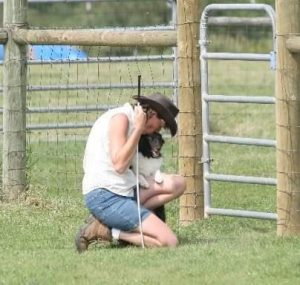
Tammy Van Deusen works with Shetland Sheepdogs in herding trials.
Herding dog trainer and Shetland Sheepdog breeder Tammy Van Deusen joins host Laura Reeves to share her knowledge.
“Give ’em the Eye”
We talk about “eye” contact, the way Border Collies and Kelpies control stock, versus “loose eye” breeds such as Shelties and the Belgian breeds, that control the stock with their movement. Van Deusen takes us through all of the testing options, what they are and how to train for them. And most importantly, she talks about the loss of genetic instinct in herding breeds.
Van Deusen’s first advice is to find a good instructor. Check out the facility before you sign up, she said. She works with clients who want to see if their dog has herding instinct. She’ll often give them three to four lessons with her “school sheep” to see if the dog will “turn on” to stock.
If the dog doesn’t have a lot of drive on stock, Van Deusen said, it can still be successful in other performance sports like agility and obedience.
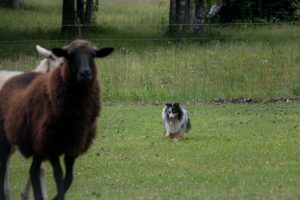
A Sheltie working stock to bring them to the handler.
One of the characteristics Van Deusen is looking for in the dogs is whether they are just chasing versus herding the stock to turn and bring it to you. “Too much prey drive won’t make a good herding dog,” she noted.
Start proving natural instinct
Different breeds work stock differently, Van Deusen said. Certain breeds, like Rottweilers and Corgis, are considered “drovers” – driving the stock forward. Border Collies and Kelpies, with their intense “eye” and low bodies were developed for working huge fields of stock to gather and bring *toward* the handler. The basic farm dog breeds, like Shelties, Tervuren and others, were developed to serve a more multi-purpose function.
“Herding judging should be about the sheep,” Van Deusen said. “They’re looking at the path the sheep are taking, are the sheep calm, more so than the dog. How the stock is moving is what the dog is doing. A good herding run is like watching paint dry. Running stock is running meat off the animals and stressing them out. A dog that works too fast, too intense, loses the rancher money.”
Genetic loss of performance skills and inherited instinct
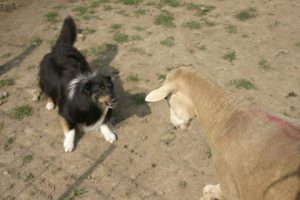
Shelties work are considered “loose eye, upright” herding breeds who work stock with their movement instead of intense eye contact.Border Collies have been bred for one thing for thousands of years, Van Deusen noted. As such, the breed’s basic instinct remains strong.
“A lot of breeds, people don’t care anymore about the herding piece,” Van Deusen said. “In two generations, you can lose instinct. I don’t think people realize that.”
272 – Pam Bruce: Memories and the Essence of Style in Purebred Dogs
Pam Bruce: Memories and the Essence of Style in Purebred Dogs

Pam Bruce and Michael Canalizo get groovy at Woofstock.
Pam Bruce, fourth generation Canadian dog fancier, joins host Laura Reeves in part one of a wide-ranging very personal interview on history, people, judging, breeding and the essence of “style” in purebred dogs.
The quintessential dog person, Bruce shares stories and humor and insight reminiscing about the legends of the sport – Michelle Billings, Jane Forsyth, Anne Rogers Clark, Michael Canalizo, Ginny Lyne, Dick Meen and many more.
Bruce finished her first dog, a Maltese, at four years old. Her family owned Maltese and later Lhasas. Perhaps best known for her association with Canalizo and the Grandeur Afghans, Bruce breeds Airedales today.
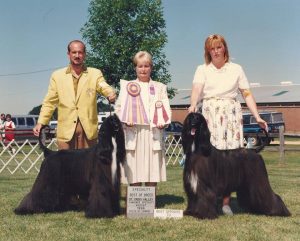
Bruce and Canalizo in competition with Ch. Tryst of Grandeur and Ch. Yours Truly of Grandeur.
Allowed to Brush
In a lifetime of “doing hair,” both brushing and hand stripping, she finds that the two coat types develop balance. “You brush away and pull towards, so the actions balance each other out.”
Steeped in the tradition of learning from the ground up, Bruce talks about the tasks that she was “allowed” to do as a young girl. Generational standing gave her no “out” on the grunt work. Being trusted with tasks like cleaning pens and brushing dogs was an “earned” privilege.
Being the first person at the dog show was a badge of honor, Bruce noted. Describing her work day as an assistant with one particular handler, she would have all toy dogs bathed before 8 am, dry them in order of their ring time and then work through the bath and blowout of the poodles, Afghan and Lhasa.

Pam Bruce showing Ch. Yours Truly of Grandeur to Best in Show.
Bruce describes the origin of her understanding of focus, being meticulous, and taking care of the dogs first.
“One thing I learned,” Bruce said. “I don’t remember a bad word being said about anyone or their dogs. Everybody has a talent and something to bring to the table. You should never ever speak of anyone poorly because together we make up what is this passion for all of us, which is this sport.”
Teamwork to keep breeding dogs
As one of the few remaining active connections to the days of big kennels, Bruce continues to emphasize dog shows as an evaluation of breeding stock.
“Those big working kennels had numbers,” Bruce said, “but that afforded us the ability to learn the quality (of the dogs).”

Pam Bruce with her homebred Airedale.
Lacking those facilities in today’s society, Bruce said teamwork picks up the slack. Sharing in a network of other Airedale breeders, “I can go back to the people working with me and get what I need.”
“Breeding is about the artform, the intrinsic qualities of the breeds,” Bruce said. “The best indicator of what you’re going to get is what you’ve had. Quality begets quality. You need to have foresight. I’m always breeding three generations ahead.”
271 — Jeff Pepper on PBGV and the Importance of Performance
Jeff Pepper on PBGV and Understanding Standards Through Performance
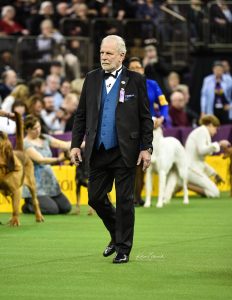
Jeff Pepper judging the hound group at Westminster Kennel Club in 2018.
Jeff Pepper, AKC judge, breeder and Take the Lead Treasurer, joined host Laura Reeves at the AKC National Championship presented by Royal Canin. Listen in for this absolutely fascinating conversation on the history and type differences of PBGV (petit basset griffon vendéen) and GBGV (grand basset griffon vendéen) and much more.
Pepper started his purebred dog journey with a pet Golden Retriever in 1968. After breeding Goldens for many years, he became involved in PBGV in 1984, importing one of the earliest dogs into the country.
“You have to watch them work”
A strong advocate for the functionality of breeds under judgement, Pepper said, “You can’t understand any breed if you haven’t seen them performing their job.” He even went so far as to attend a duck tolling test
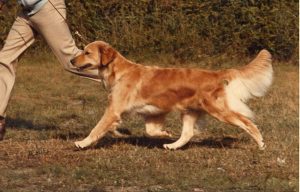
Ch Pepperhill East Point Airily, BOB at the 1984 Golden National and a multiple BIS winner. She was owned by Dan Flavin and Helene Geary.
for the Nova Scotia Duck Tolling Retrievers to understand the nuances of the breed.
Grooming to meet the standard
Following suit with the functionality, Pepper is also a stickler for a more natural look in the ring, particularly on those sporting and hound breeds whose standards call for minimal grooming. He advocates presentation based on performance requirements.
“When you over-neaten these dogs, you take away basic characteristics of the breeds,” Pepper said.
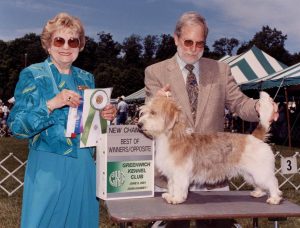
A PBGV Pepper whelped in the late ’90s.
Needless to say, this doesn’t mean to show him a dirty dog, but “if you wash the dog two hours before you show, it makes a soft coat,” Pepper reminded. Specifically, the PBGV and GBGV coats are 2-3 inches long, “like a goat.”
And while he doesn’t recommend not grooming at all, he advised exhibitors to understand they are not supposed to pull all of the coat off the PBGV or the GBGV. “They are not scissored. Don’t pull too much out, it doesn’t come back quickly. The hole will be there a while. Trim in front of a mirror. The dogs should be neat but not overly neat. A little unevenness. A little rustic,” Pepper said.
History of the rough coated French Hounds
Pepper’s in-depth observations on the character, type and history of the breeds is must-listen content. It isn’t just a size difference, Pepper noted. “Everything is longer on the GBGV – legs, ears, tail, body – but the differences in head planes, skull structure and more are critical.”

An avid amateur photographer, Pepper travels to Africa regularly.
270 – David Fitzpatrick on Pekingese, the Palace Dogs of Peking
David Fitzpatrick on Pekingese, the Palace Dogs of Peking
David Fitzpatrick, 2012 Westminster Kennel Club BIS winner with the Pekingese, Malachy, was obsessed with dogs as a child. Although his parents wouldn’t let him own a dog, he found ways to be involved with them by walking and housesitting dogs in the neighborhood.

David Fitzpatrick receiving the Westminster Kennel Club BIS ribbon from judge Cindy Vogels.
His passion took off around 1970 when he wrote a letter to a local handler to see if she needed help. Before he knew it, he was being picked up after school, earning $5/day helping her with Pekingese and other toy breeds.
“It could have been pretty much any breed,” Fitzpatrick said. “I fell into the lap of the Pekingese and loved them from the start. It was fate really.”
“Speak to anyone who is remotely involved with the Pekingese breed and the mention of David Fitzpatrick’s name will result in a degree of awe and reverence, for this American gentleman is acknowledged as being as fine a handler and presenter of a Pekingese as has ever been seen,” says noted British author Andrew Brace.
What is it about Pekingese?
The dogs of royalty in China, the first Pekingese specialty show was held in the US around 1908, Fitzpatrick said. “The breed attracted the pillars of society. They were the status symbol dog of the day and were the most popular toy breed into the ‘60s.”
“It is a detail oriented breed,” Fitzpatrick noted, “with their pear shaped body, rectangular head, features spread out and not crowded, heavy bone, crooked legs, level back and high tail set.”
Pekingese should have an intelligent expression, one that is almost arrogant and disdainful.
“Their true temperament is snooty,” Fitzpatrick said. “They were developed as palace dogs in China. They were royalty and had their own servants. They are generally waiting for you to do for them. It’s not a breed that really wants to please their humans.”
Pekes as pets
Fitzpatrick said the breed is great to live with. “They blend into the household,” he noted. “They get their loves and then go entertain themselves. They’re not constantly clawing at you like some dogs. They’re more independent.”
Pekingese have a great deal of personality, Fitzpatrick added. While they are at a show they are performing, showing their regal and aristocratic nature. At home, they’re like any other dogs, they chase squirrels and his dogs even dug out a nest of baby bunnies.
Breed specific presentation
“It’s up to us to show our dogs in a proper manner, not succumb to this crazy show biz of dogs chasing bait around the ring… an aristocratic breed really should not be begging for food, should they?”

